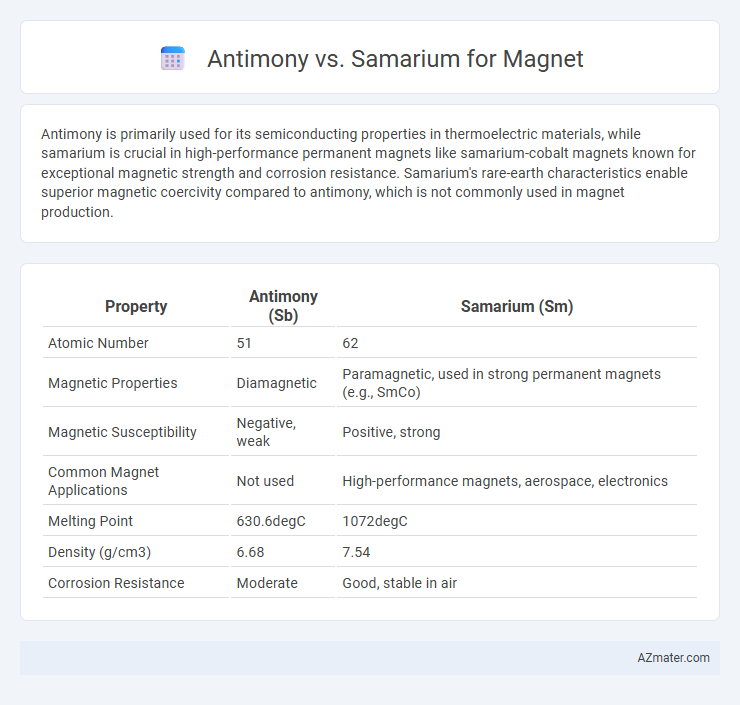Antimony is primarily used for its semiconducting properties in thermoelectric materials, while samarium is crucial in high-performance permanent magnets like samarium-cobalt magnets known for exceptional magnetic strength and corrosion resistance. Samarium's rare-earth characteristics enable superior magnetic coercivity compared to antimony, which is not commonly used in magnet production.
Table of Comparison
| Property | Antimony (Sb) | Samarium (Sm) |
|---|---|---|
| Atomic Number | 51 | 62 |
| Magnetic Properties | Diamagnetic | Paramagnetic, used in strong permanent magnets (e.g., SmCo) |
| Magnetic Susceptibility | Negative, weak | Positive, strong |
| Common Magnet Applications | Not used | High-performance magnets, aerospace, electronics |
| Melting Point | 630.6degC | 1072degC |
| Density (g/cm3) | 6.68 | 7.54 |
| Corrosion Resistance | Moderate | Good, stable in air |
Introduction to Antimony and Samarium in Magnetics
Antimony and samarium are critical elements in magnetics, with samarium being a key component in high-performance rare-earth magnets like samarium-cobalt (SmCo), known for their exceptional magnetic strength and temperature stability. Antimony, although less prominent in direct magnetic applications, is utilized in alloy forms to enhance magnetic properties and improve material hardness in magnetic devices. The distinct roles of samarium and antimony emphasize samarium's importance in permanent magnet manufacturing and antimony's function in supporting magnetic material durability and performance.
Chemical and Physical Properties Comparison
Antimony (Sb) and Samarium (Sm) differ significantly in chemical and physical properties relevant to magnet applications, with Samarium being a rare-earth metal known for its strong magnetic properties and high magnetic anisotropy, crucial for permanent magnets like samarium-cobalt (SmCo) alloys. Antimony, a metalloid, lacks inherent magnetic properties and instead serves primarily as an alloying element to improve mechanical strength and corrosion resistance rather than magnetism. Samarium's high melting point (1072degC) and relatively stable electron configuration enable the formation of robust, high-performance magnets, whereas Antimony's lower melting point (631degC) and non-magnetic nature limit its direct use in magnetic materials.
Magnetic Characteristics of Antimony
Antimony exhibits weak diamagnetic properties, making it less effective for magnet applications compared to samarium, which is a rare earth element with strong ferromagnetic characteristics. Samarium's magnetic strength, particularly in samarium-cobalt magnets, surpasses antimony due to its high coercivity and thermal stability. Antimony's limited magnetic responsiveness restricts its use primarily to semiconductor roles rather than as a material for permanent magnets.
Magnetic Behavior of Samarium
Samarium exhibits strong magnetic behavior due to its unpaired 4f electrons, making it a key component in samarium-cobalt (SmCo) magnets known for high coercivity and thermal stability. In contrast, antimony is a non-magnetic metalloid with negligible contribution to magnetic properties in materials. The superior magnetic performance of samarium-based magnets is critical in high-temperature and high-performance applications such as aerospace and military technologies.
Applications of Antimony-Based Magnets
Antimony-based magnets are primarily used in high-temperature applications and thermoelectric devices due to their exceptional magnetic stability and corrosion resistance. These magnets offer efficient performance in automotive sensors, electrical motors, and precise instrumentation where durability under heat stress is crucial. In contrast, samarium magnets, known for their strong magnetic strength, are preferred in compact electronics and advanced aerospace technologies requiring high coercivity but are less suited for high-temperature environments compared to antimony-based options.
Uses of Samarium in High-Performance Magnets
Samarium is a critical element in the production of high-performance magnets, especially samarium-cobalt (SmCo) alloys, known for their excellent thermal stability and strong magnetic properties. Unlike antimony, which is primarily used in flame retardants and lead alloys, samarium's unique ability to maintain magnetization at elevated temperatures makes it indispensable for advanced electronics, aerospace, and military applications. The superior corrosion resistance and high coercivity of samarium-based magnets ensure reliable performance in extreme environments where neodymium magnets may fail.
Pros and Cons: Antimony Magnets
Antimony magnets offer strong corrosion resistance and high-temperature stability, making them suitable for challenging environments and industrial applications. However, their magnetic strength is generally lower compared to samarium magnets, limiting their effectiveness in high-performance settings. Antimony's cost-effectiveness and durability provide practical advantages despite a trade-off in magnetic power.
Pros and Cons: Samarium Magnets
Samarium magnets, primarily samarium-cobalt alloys, exhibit exceptional magnetic strength, high resistance to corrosion, and stability at elevated temperatures, making them ideal for demanding industrial applications. However, these magnets are brittle, prone to cracking under mechanical stress, and typically more expensive than neodymium or ferrite magnets. While antimony-based materials do not conventionally form strong permanent magnets, samarium magnets provide superior performance in areas requiring reliability under extreme conditions.
Cost and Availability Analysis
Antimony is significantly more abundant and less expensive compared to samarium, making it a cost-effective choice for magnet production. Samarium, a rare earth element essential for high-performance samarium-cobalt (SmCo) magnets, has limited availability and higher extraction costs due to complex mining processes and geopolitical factors. The price volatility and scarcity of samarium impact supply chain stability, while antimony remains more accessible but offers lower magnetic performance.
Which Element is Better for Magnet Manufacturing?
Samarium is better suited for magnet manufacturing due to its strong magnetic properties and high coercivity, especially in samarium-cobalt (SmCo) magnets known for their thermal stability and resistance to demagnetization. Antimony, on the other hand, does not exhibit significant magnetic characteristics and is primarily used in alloys and flame retardants rather than magnetic applications. Therefore, samarium is the preferred element for producing high-performance permanent magnets used in advanced technologies like electric motors and aerospace.

Infographic: Antimony vs Samarium for Magnet
 azmater.com
azmater.com